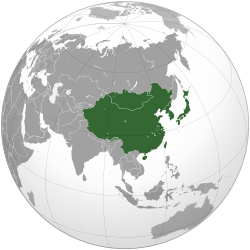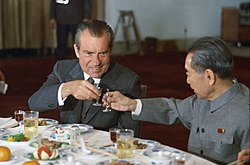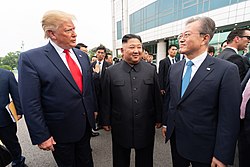| President | Dates | Countries | Locations | Key details |
|---|
| Dwight D. Eisenhower [1] | December 2–5, 1952 |  South Korea South Korea | Seoul | Visit to Korean combat zone. (Visit made as President-elect.) |
| June 18–19, 1960 |  Taiwan Taiwan | Taipei | State visit. Met with President Chiang Kai-shek |
| June 19–20, 1960 |  South Korea South Korea | Seoul | Met with Prime Minister Heo Jeong. Addressed the National Assembly. |
| Lyndon B. Johnson [2] | October 31 – November 2, 1966 |  South Korea South Korea | Seoul,
Suwon | State visit. Met with President Park Chung-hee and Prime Minister Chung Il-kwon. Addressed National Assembly. |
| Richard Nixon [3] | February 21–28, 1972 |  China China | Shanghai,
Beijing,
Hangzhou | State Visit. Met with CCP chairman Mao Zedong and Premier Zhou Enlai. |
| Gerald Ford | November 19–22, 1974 |  Japan Japan | Tokyo,
Kyoto | State visit. Met with Prime Minister Kakuei Tanaka. |
| November 22–23, 1974 |  South Korea South Korea | Seoul | Met with President Park Chung-hee. |
| December 1–5, 1975 |  China China | Beijing | Official visit. Met with CCP chairman Mao Zedong and Vice Premier Deng Xiaoping |
| Jimmy Carter [4] | June 25–29, 1979 |  Japan Japan | Tokyo,
Shimoda | State visit; met with Emperor Hirohito and Prime Minister Masayoshi Ōhira. Attended the 5th G7 summit. |
| June 29 – July 1, 1979 |  South Korea South Korea | Seoul | State visit. Met with President Park Chung-hee and Prime Minister Choi Kyu-hah. |
| July 9–10, 1980 |  Japan Japan | Tokyo | Official visit; attended memorial services for former Prime Minister Masayoshi Ōhira; met with Emperor Hirohito, President Ziaur Rahman of Bangladesh, Prime Minister Malcolm Fraser of Australia, Prime Minister Prem Tinsulanonda of Thailand, and Premier Hua Guofeng of China. |
| Ronald Reagan [5] | November 9–12, 1983 |  Japan Japan | Tokyo | State visit; met with Emperor Hirohito and Prime Minister Yasuhiro Nakasone and addressed the National Diet. |
| November 12–14, 1983 |  South Korea South Korea | Seoul,
Demilitarized Zone | State visit. Met with President Chun Doo-hwan. Addressed the National Assembly and visited U.S. troops. |
| April 26 – May 1, 1984 |  China China | Beijing,
Xi'an,
Shanghai | State visit. Met with CCP general secretary Hu Yaobang, President Li Xiannian and Premier Zhao Ziyang. |
| May 2–7, 1986 |  Japan Japan | Tokyo | Attended the 12th G7 summit. |
| George H. W. Bush [6] | February 23–25, 1989 |  Japan Japan | Tokyo | Attended the funeral of Emperor Hirohito. Met with Emperor Akihito, the kings of Belgium, Jordan and Spain, the presidents of Brazil, Egypt, France, the Federal Republic of Germany, Israel, Italy, Nigeria, the Philippines, Portugal and Zaire, and the prime ministers of Japan, Pakistan, Singapore, Thailand and Turkey. |
| February 25–27, 1989 |  China China | Beijing | Met with CCP general secretary Zhao Ziyang, President Yang Shangkun and Premier Li Peng. Also met with Prince Norodom Sihanouk of Cambodia. |
| February 27, 1989 |  South Korea South Korea | Seoul | Official visit. Addressed the National Assembly. |
| January 5–7, 1992 |  South Korea South Korea | Seoul | Met with President Roh Tae-woo and senior Korean officials. Also signed a science and technology agreement, addressed the National Assembly, and visited U.S. military personnel. |
| January 7–10, 1992 |  Japan Japan | Kyoto,
Kashihara,
Tokyo | Met with Emperor Akihito, Prime Minister Kiichi Miyazawa and senior Japanese officials. |
| Bill Clinton [7] | July 6–10, 1993 |  Japan Japan | Tokyo | Attended the 19th G7 summit. Met with Russian president Boris Yeltsin. |
| July 10–11, 1993 |  South Korea South Korea | Seoul | Met with President Kim Young-sam. Addressed the National Assembly. Visited U.S. military personnel. |
| April 15–16, 1996 | Cheju Island | Met with President Kim Young-sam. Proposed four-nation peace talks. |
| April 16–18, 1996 |  Japan Japan | Tokyo | State visit. Issued joint statement on U.S.-Japanese security relations. Addressed the Diet and U.S. Navy personnel. |
| June 24 – July 3, 1998 |  China China | Xi'an,
Beijing,
Shanghai,
Guilin,
Hong Kong | State visit. Met with President & CCP general secretary Jiang Zemin. Visited the Forbidden City and the Great Wall of China. Delivered a speech at Peking University. |
| November 19–20, 1998 |  Japan Japan | Tokyo | Met with Emperor Akihito and Prime Minister Keizō Obuchi. Addressed American Chamber of Commerce. |
| November 20–22, 1998 |  South Korea South Korea | Seoul,
Osan | Met with President Kim Dae-jung. Addressed U.S. military personnel. |
| June 8, 2000 |  Japan Japan | Tokyo | Attended the funeral of former Prime Minister Keizō Obuchi. |
| July 21–23, 2000 | Nago | Attended the 26th G8 summit. |
| George W. Bush [8] | October 18–21, 2001 |  China China | Shanghai | Attended the APEC Summit. |
| February 16–19, 2002 |  Japan Japan | Tokyo | Met with Emperor Akihito and Prime Minister Junichiro Koizumi. Addressed the Diet. |
| February 19–21, 2002 |  South Korea South Korea | Seoul,
Dorasan,
Osan | Met with President Kim Dae-jung. Visited the Korean Demilitarized Zone. Addressed U.S. military personnel. |
| February 21–22, 2002 |  China China | Beijing | Met with President & CCP general secretary Jiang Zemin and Premier Zhu Rongji. |
| October 17–18, 2003 |  Japan Japan | Tokyo | Met with Prime Minister Junichiro Koizumi. |
| November 15–16, 2005 | Kyoto | Met with Prime Minister Junichiro Koizumi. |
| November 16–20, 2005 |  South Korea South Korea | Pusan,
Gyeongju,
Osan | Attended the APEC Summit. Met with Russian president Vladimir Putin. Addressed U.S. military personnel. |
| November 20–21, 2005 |  China China | Beijing | Met with President & CCP general secretary Hu Jintao and Premier Wen Jiabao. |
| November 21, 2005 |  Mongolia Mongolia | Ulaanbaatar | Met with President Nambaryn Enkhbayar and Prime Minister Tsakhiagiin Elbegdorj. |
| July 6–9, 2008 |  Japan Japan | Tōyako | Attended the 34th G8 summit. Met with Tanzanian president Jakaya Kikwete, Indian prime minister Manmohan Singh, Chinese leader Hu Jintao and South Korean president Lee Myung-bak. |
| August 5–6, 2008 |  South Korea South Korea | Seoul | Met with President Lee Myung-bak. Addressed U.S. military personnel. |
| August 7–11, 2008 |  China China | Beijing | Attended the opening ceremonies of the Summer Olympics. Met with President & CCP General Secretary Hu Jintao and Russian Prime Minister Vladimir Putin. |
| Barack Obama [9] | November 13–14, 2009 |  Japan Japan | Tokyo | Met with Emperor Akihito and Prime Minister Yukio Hatoyama. |
| November 15–18, 2009 |  China China | Shanghai,
Beijing | Met with Shanghai Party Secretary Yu Zhengsheng and Mayor Han Zheng; also took part in a town hall meeting with Shanghai students. Met with President & CCP general secretary Hu Jintao, NPC chairman Wu Bangguo and Premier Wen Jiabao. Visited the Forbidden City and the Great Wall of China. |
| November 18–19, 2009 |  South Korea South Korea | Seoul, Osan | Met with President Lee Myung-bak. Visited with U.S. troops at Osan Air Base. |
| November 10–12, 2010 |  South Korea South Korea | Seoul | Attended the G-20 Summit. Met with President Lee Myung-bak. |
| November 12–14, 2010 |  Japan Japan | Yokohama, Kamakura | Attended the APEC Summit. Met with Prime Minister Naoto Kan. |
| March 25–27, 2012 |  South Korea South Korea | Seoul | Attended the Nuclear Security Summit. Met with President Lee Myung-bak. Visited the Korean Demilitarized Zone. |
| April 23–25, 2014 |  Japan Japan | Tokyo | Met with Emperor Akihito and Prime Minister Shinzō Abe. |
| April 25–26, 2014 |  South Korea South Korea | Seoul | Met with President Park Geun-hye. Visited with U.S. troops at Yongsan Garrison. |
| November 10–12, 2014 |  China China | Beijing | Attended the APEC Summit. Met with President & CCP General Secretary Xi Jinping, Premier Li Keqiang and NPC Chairman Zhang Dejiang. [10] |
| May 25–27, 2016 |  Japan Japan | Shima,
Hiroshima | Attended the 42nd G7 summit. Visited the Hiroshima Peace Memorial Park. |
| September 3–6, 2016 |  China China | Hangzhou | Attended the G-20 Summit. |
| Donald Trump | November 5–7, 2017 |  Japan Japan | Tokyo | Met with Emperor Akihito and Prime Minister Shinzō Abe. |
| November 7–8, 2017 |  South Korea South Korea | Seoul | Met with President Moon Jae-in. Addressed the National Assembly. |
| November 8–10, 2017 |  China China | Beijing | Met with President & CCP general secretary Xi Jinping and Premier Li Keqiang. |
| May 25–28, 2019 |  Japan Japan | Tokyo,
Yokosuka | State visit. Met with Emperor Naruhito and Prime Minister Shinzō Abe. |
| June 27–29, 2019 |  Japan Japan | Osaka | Attended the G-20 Summit. |
| June 29–30, 2019 |  South Korea South Korea | Seoul,
Korean Demilitarized Zone | Met with President Moon Jae-in. Visited the Korean Demilitarized Zone. Attended the Koreas–United States DMZ Summit with President Moon and North Korean leader Kim Jong-un at the Inter-Korean Freedom House on the southern side of the Joint Security Area of the Korean Demilitarized Zone. Visited U.S. troops at Osan Air Base. |
| June 30, 2019 |  North Korea North Korea | Joint Security Area | Briefly walked into the northern side of the Joint Security Area of the Korean Demilitarized Zone, accompanied by North Korean Leader Kim Jong-un, becoming the first sitting U.S. president to enter North Korea. |
| Joe Biden | May 20–22, 2022 |  South Korea South Korea | Seoul | Met with President Yoon Suk-yeol. Visited with U.S. troops at Yongsan Garrison. |
| May 22–24, 2022 |  Japan Japan | Tokyo | Met with Emperor Naruhito and Prime Minister Fumio Kishida. Attended the QUAD Leaders Summit with Prime Minister Kishida, Australian prime minister Anthony Albanese, and Indian prime minister Narendra Modi. |
| May 18–21, 2023 |  Japan Japan | Hiroshima | Attended the 49th G7 summit. |
| Donald Trump | October 27–29, 2025 |  Japan Japan | Tokyo,
Yokosuka | Met with Emperor Naruhito and Prime Minister Sanae Takaichi. |
| October 29–30, 2025 |  South Korea South Korea | Busan,
Gyeongju | Met with President Lee Jae Myung in Busan. Attended the APEC Summit. Also met with Chinese leader Xi Jinping. |




